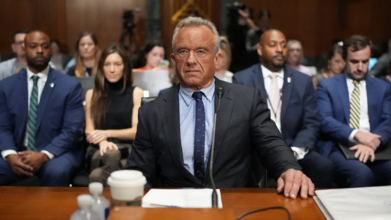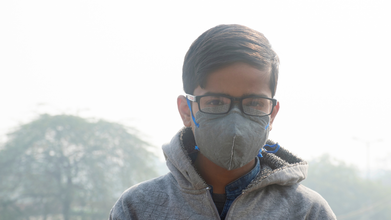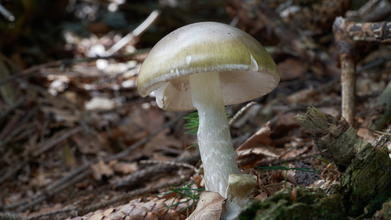- Health Conditions A-Z
- Health & Wellness
- Nutrition
- Fitness
- Health News
- Ayurveda
- Videos
- Medicine A-Z
- Parenting
‘We Were Lied To About Everything Around COVID,’ Says RFK Jr. At Vaccine Hearings

Credits: Reuters
The COVID-19 pandemic continues to cast a long shadow over public trust, scientific institutions, and political leadership. On Thursday, Health and Human Services Secretary Robert F. Kennedy Jr. reignited controversy during a Senate Finance Committee hearing, claiming that the federal government had misled Americans about nearly every aspect of the pandemic response. His comments touched off a heated debate that underscored just how polarizing the conversation around vaccines, masks, and public health remains—even five years after the virus first spread across the globe.
When asked by Senator John Cornyn (R-Texas) whether he believed COVID-19 had been politicized, Kennedy’s response was blunt: “The whole process was politicized. We were lied to about everything.” He accused the Centers for Disease Control and Prevention (CDC) and other federal agencies of concealing the truth about natural immunity, overstating the power of vaccines to block transmission, and misleading the public on the effectiveness of cloth masks.
Also Read: Joe Biden Undergoes Surgery To Remove Skin Cancer Months After Prostate Cancer Diagnosis
Kennedy framed his stance as an effort to “eliminate politics from science,” but his words also echoed his long history of skepticism toward vaccines, a position that has drawn sharp criticism from leading medical organizations.
Vaccines and the Debate Over Transmission
One of Kennedy’s more pointed critiques involved the early messaging on COVID-19 vaccines. In 2021, then-CDC Director Rochelle Walensky said data suggested vaccinated individuals “do not carry the virus, don’t get sick.” That statement, later walked back, has since been cited by skeptics as evidence of misleading communication.
The official guidance at the time, however, noted that vaccines primarily reduced the risk of severe illness and transmission—they did not guarantee complete immunity. Subsequent data confirmed that while breakthrough infections occurred, vaccination significantly lowered the risk of hospitalization and death. Critics argue that Kennedy’s selective framing ignores this broader reality.
Mask Guidance: Shifting Science or Mixed Messaging?
Kennedy also attacked the government’s changing stance on masks. Early in the pandemic, cloth masks were encouraged when medical-grade masks were in short supply. Over time, the CDC emphasized higher filtration masks like N95s and KN95s as the standard for protection.
Public health experts acknowledge that these shifts were confusing but stress they reflected evolving evidence and supply-chain realities, not intentional deception. Kennedy, however, portrayed them as emblematic of a government that “failed miserably during COVID.”
COVID-19 In US: How Many Died?
The most tense exchange of the hearing came when Senator Mark Warner (D-Va.) pressed Kennedy on the U.S. death toll. “How many Americans died from COVID-19?” Warner asked. Kennedy responded: “I don’t think anybody knows.”
According to CDC data—an agency Kennedy oversees—over 1.23 million Americans have died from COVID-19 as of August 2025. Warner, visibly frustrated, accused the health secretary of ignorance and undermining public confidence. “You are sitting as Secretary of Health and Human Services—how can you be that ignorant?” Warner demanded.
Kennedy countered by accusing the Biden administration of creating “data chaos,” suggesting inconsistencies in mortality reporting eroded public trust.
Tensions Over Vaccine Access
The hearing also spotlighted vaccine access. Senator Bill Cassidy (R-La.), a physician, challenged Kennedy over his role in narrowing vaccine recommendations and replacing expert panels with his own appointees. Cassidy warned that conflicting guidance was making it harder for Americans to access booster shots.
“Effectively, we are denying people vaccines,” Cassidy said. Kennedy flatly rejected the claim: “You’re wrong.” The clash highlighted an underlying paradox—while Kennedy acknowledged Trump’s Operation Warp Speed as a success deserving of a Nobel Prize, he has simultaneously pursued policies that critics say restrict vaccine uptake.
The Fallout at CDC and Leadership Shake-Ups
Kennedy defended his decision to fire CDC Director Susan Monarez after less than a month on the job, a move that triggered several high-level resignations. He called the shake-ups “absolutely necessary,” arguing that the CDC’s leadership had “failed miserably during COVID.”
His critics, including more than 20 medical societies calling for his resignation, argue the opposite—that Kennedy has destabilized one of the country’s most vital public health agencies at a critical time. For them, the firing represents not accountability, but a dismantling of scientific infrastructure.
Fractured Trust in Science and Government
Kennedy’s claim that “we were lied to about everything” taps into deep public skepticism that grew throughout the pandemic. Mixed messaging on masks, shifting vaccine recommendations, and partisan rhetoric all fueled a breakdown in trust.
But public health experts caution that framing this as deliberate deceit oversimplifies a far more complex reality. Science evolves with new data, and policies must adapt accordingly. While communication missteps occurred, the broad consensus among experts remains that vaccines saved millions of lives, masks reduced spread, and public health interventions—though imperfect—were essential.
A Political and Public Health Crossroads
What Kennedy’s testimony underscored most clearly is the enduring politicization of COVID-19. His words resonated with those already skeptical of government institutions but alarmed many physicians and scientists who see them as undermining progress in future health crises.
The tension between politics and public health is unlikely to fade. With respiratory virus season approaching, debates over vaccines, mask mandates, and data transparency remain unresolved. The hearing revealed not just disagreements over past actions, but ongoing battles over how the U.S. should prepare for future pandemics.
Robert F. Kennedy Jr.’s claim that Americans “were lied to about everything” may capture the anger of those disillusioned with government response, but it also risks entrenching misinformation. The legacy of COVID-19 is not only measured in lives lost but also in fractured trust between citizens, science, and leadership.
As policymakers and public health leaders move forward, the question remains, will lessons from the pandemic bring stronger systems and clearer communication, or will the scars of political division continue to shape health policy for years to come?
This is a developing story, we are looking into data mentioned and will bring you more detailed information soon.
Health Emergency Looms As Delhi Forms Expert Panel To Fight Air Pollution

Credits: iStock
Coughs. Sneezing. Wheezing. All of this can be heard everywhere, with many people taking sick leaves, and coming back to office still with health complains. This is what is happening in Delhi as the national capital remains in the 'very poor' category for its Monday morning Air Quality Index (AQI). The average AQI of the city stood at 318 on 7am, as per the Central Pollution Control Board (CPCB). The thick layer of smog has engulfed the city and there has been no improvement to get rid of the toxic air. Visibility too has been reduced in several areas, including Anand Vihar, India Gate, Dwarka, and ITO.
Amid the continuously worsening air condition in Delhi, the government has now formed an 'expert group' to combat air pollution as health crisis rise.
The panel will study how pollution builds up from human activity as well as natural causes and will recommend technology upgrades, policy reforms, and sector specific interventions that can be put into action.
Who Will Lead the Expert Panel
The group will be chaired by retired IAS officer and former Union Environment Secretary Leena Nandan. Other members include former CPCB member secretary Dr JS Kamyotra, IIT Delhi professor emeritus Mukesh Khare, IIT Kanpur professor emeritus Mukesh Sharma, and Dr Suneel Pandey, director of Circular Economy and Waste Management at TERI. Representatives from CAQM, the IMD, APAG, PHDCCI and senior officials from the Delhi government are also part of the group. The Secretary of Environment and Forest is a member, and the DPCC chairman will serve as member secretary.
What the Group Will Do
This expert panel will act as a high level advisory body, offering clear, actionable guidance that can shape both emergency responses and long term reforms. It will track the progress of current pollution control programs, study global best practices, and flag where corrections are needed. The group will meet every month, either in person or virtually, and will receive administrative support from the Delhi Pollution Control Committee. The initial tenure is six months, with the option to extend if required.
Government Planning and Oversight
Chief Minister Rekha Gupta has approved the expert group, along with a separate High Level Implementation Committee chaired by the Chief Secretary. While the expert group will guide policy and strategy, the implementation committee is responsible for enforcing directives, coordinating across departments, and ensuring timely action. Delhi BJP leader Manjinder Singh Sirsa has welcomed the move and said that combined efforts from the government and citizens can make a meaningful difference.
Delhi’s Pollution Levels Are Rising Fast
A new analysis by the Centre for Research on Energy and Clean Air (CREA) highlights the scale of the crisis. Delhi’s air pollution almost doubled in November, with average PM2.5 levels touching 215 micrograms per cubic meter. The city recorded 23 days of very poor air, six severe days, and only one poor day. Although stubble burning played a smaller role this year, contributing an average of 7 percent, the pollution remained dangerously high.
Across India, pollution trends were equally worrying. Nine of the ten most polluted cities saw higher pollution levels than last year. Ghaziabad was the worst affected, with PM2.5 levels at 224 micrograms per cubic meter.
According to CREA analyst Manoj Kumar, declining stubble burning shows some progress, but major year round sources such as transport, industry, power plants, and other combustion activities continue to drive the crisis. Without strong emission cuts in these sectors, pollution levels will keep breaching national standards.
Doctors Warn of a Deepening Health Emergency
In an interview with ANI, doctors from AIIMS described Delhi’s air quality as a medical emergency. Prof Dr Anant Mohan and Dr Saurabh Mittal from the Department of Pulmonary, Critical Care, and Sleep Medicine said the current situation is now putting vulnerable groups at serious risk, including pregnant women, unborn babies, newborns, and adults with heart or neurological conditions.
Dr Mohan warned that the impacts may be felt for generations. Since the particles are extremely small, they can pass from a pregnant woman to the fetus and interfere with growth. Babies exposed to such conditions in the womb are more likely to be underweight and may have weaker lungs as they grow. Some complications might show up only later in life.
Dr Mittal added that the effects of toxic air go far beyond respiratory illness. Prolonged exposure is increasing cases of breathlessness, lung inflammation, asthma attacks, and chronic conditions like COPD. Fine particulate matter is also entering the bloodstream, raising the risk of heart attacks and strokes.
The growing health concerns underline the need for immediate and coordinated action, making the work of the newly formed expert group even more urgent.
How To Read Delhi's AQI?
0-50: 'good'
51-100: 'satisfactory'
101-200: 'moderate'
201-300: 'poor'
301-400: 'very poor'
401-500: 'severe'
Unique Symptoms Of H3N2 Flu Strain In UK And How Long Infection Now Last

Credits: iStock
It is that time of the year when cough and colds are at its peak and everyone you know if affected by it. However, the health experts have warned that this winter could be worst, worse than the previous one. Why? Because this winter may have the most severe flu outbreaks in decades. The worst part? It is already wreaking havoc on the NHS.
The flu strain being talked about here is the H3N2 strain, what has also been named as the "unpleasant" by health experts. The experts have warned that NHS could face a "tidal wave" of illness ahead of Christmas. A per the reports, hospital admission rates for flu has already gone up to 56 per cent, as compared to the same week last year. As per the health experts, wearing a mask outside is must, especially if they feel unwell, and have encourages those who are eligible to get their vaccination.
What Is the H3N2 Strain?
H3N2 is one of the two main influenza strains currently in circulation. Also referred to as subclade K, it is the most prevalent flu strain in England right now, according to the UK Health Security Agency (UKHSA).
What Are The Doctors Saying?
The Independent spoke to Dr Giuseppe Aragona, GP and a medical adviser for Prescription Doctor, about this new strain and the ways to prevent sickness.
Dr Aragona explained that the letters and numbers used to classify flu strains come from the virus’s surface proteins called haemagglutinin, represented by H, and neuraminidase, represented by N.
He said that this specific combination can sometimes lead to more serious illness, particularly in older adults and people with underlying health conditions.
He added that H3N2 changes frequently, which means the version circulating this year may differ from earlier years or from the strain included in the seasonal vaccine. This can leave people more vulnerable to infection.
What are the symptoms?
According to the UKHSA, flu symptoms tend to appear suddenly. Extreme tiredness is common and this often helps distinguish flu from a cold, which develops more gradually.
The symptoms linked to H3N2 have been similar to typical seasonal flu. These may include fever, cough, a runny nose, body aches, vomiting or diarrhea.
People at higher risk of complications include children under five, especially those under two, adults over 65, pregnant women and individuals with chronic medical conditions such as asthma, diabetes, heart disease, weakened immunity or neurological illnesses.
If someone develops flu symptoms after close contact with pigs, doctors advise informing a healthcare provider immediately and mentioning that exposure.
How high are flu rates right now?
NHS England reported that an average of 1,717 patients a day were admitted to hospital with flu last week. This is a 56 per cent rise from the same period last year.
- The rates are seven times higher than in 2023, when hospitals saw an average of 243 flu patients a day.
- This spike follows Australia’s biggest flu season on record, which often predicts how the UK will fare.
Why is H3N2 hitting harder this winter?
Dr Aragona said several factors are contributing to a more challenging flu season. The season has begun earlier than usual, giving the virus more opportunity to spread.
He added that the strain has evolved from last year’s version, so immunity from previous infections and even the vaccine may offer less protection.
He also pointed out that fewer people have been exposed to flu in recent years, especially children. This means a larger portion of the population is susceptible. Cold weather, indoor gatherings and normal social habits are also helping the virus spread more easily.
Experts have already noted that this strain picked up seven new mutations over the summer, making it quite different from previous versions in the current vaccine.
With winter underway, the UK is preparing for a rise in flu related deaths. NHS leaders have issued a strong appeal for people to get vaccinated. Last winter saw around 8,000 deaths linked to flu. This was higher than the previous year’s 3,500 deaths but lower than the 16,000 recorded in the 2022 to 2023 season.
How can you protect yourself?
Dr Aragona said getting the flu vaccine is the most important step, especially for people who are older, pregnant, very young or managing long term health conditions.
He said the vaccine does not prevent every infection but it greatly reduces the chances of severe illness and hospitalisation.
Good hand hygiene, covering your mouth and nose when coughing or sneezing, avoiding close contact with sick individuals and keeping indoor spaces well ventilated can also help.
New data from the UKHSA shows the 2025 to 2026 vaccine is currently 70 to 75 per cent effective at preventing hospital visits in children aged two to seventeen, and 30 to 40 per cent effective in adults.
Dr Jamie Lopez Bernal of the UKHSA said the early results offer reassuring evidence that this year’s vaccine provides meaningful protection. He encouraged everyone eligible to get vaccinated as soon as possible.
Dr Thomas Waite, deputy chief medical officer, said flu can be unpleasant for many people and dangerous for some. He emphasised that vaccination is the best defence. He said the season has started early and that those eligible should get their vaccine now.
Last year’s flu vaccine significantly reduced the number of severe cases, cutting hospitalisation by nearly 40 per cent in people over 65 and by 75 per cent in children aged two to seventeen.
How worried should we be about H3N2?
Dr Aragona said that while flu can be uncomfortable, most healthy adults and children recover without complications. He advised against panic but highlighted that older people, those with chronic illnesses and other vulnerable groups could face more serious illness this season.
He said the key is staying alert, getting vaccinated, taking sensible precautions and seeking medical help early if symptoms worsen. With these steps, he said the risks can be managed, even in a year with higher flu activity.
One Dead, 21 Poisoned: California Sounds Alarm Over Toxic Death Cap Mushrooms; Here's How To Identify Them

Credits: iStock
Officials in California have now urged people to not forage for wild mushrooms after a rise in poisoning cases that caused at least one death. The California Poison Control System was able to identify at least 21 cases of poisoning in northern California. This has resulted from death cap mushrooms, confirmed the state's public health department.
How Bad Is The Mushroom Poisoning?
The poisoning has resulted in severe liver damage in people and have not spared even children. It has killed at least one of the patients who may have needed a liver transplant, confirmed the health department.
The problem is that death cap mushrooms could be easily mistaken for safe, edible mushrooms because of its similar taste, smell, and appearance.
What Do Health Officials Say?
Health officials have confirmed that the recent cases occurred between mid November and early December, a period marked by heavy rainfall in the region. The wet weather creates perfect conditions for the toxic death cap mushroom to thrive, especially around oaks and other hardwoods, including pine trees, according to the California Department of Public Health (CDPH).
While most cases have been concentrated in Monterey and the San Francisco Bay Area, the CDPH cautioned that the danger extends across California.
“Death cap mushrooms contain toxins that can cause life threatening liver failure,” said Dr Erica Pan, CDPH Director and State Public Health Officer. “Because these mushrooms can be easily confused with edible varieties, we strongly urge the public to avoid foraging for wild mushrooms during this high risk season.”
The agency stressed that death caps are unsafe under any circumstances. Cooking, freezing, boiling or drying them does not remove their toxicity.
Consuming the mushroom can trigger symptoms such as nausea, vomiting, watery diarrhoea, abdominal pain and dehydration within six to 24 hours. Although the discomfort may briefly subside, serious or even fatal liver damage can develop up to eight days later.
“Only individuals with significant expertise in identifying wild mushrooms should eat those they have harvested themselves,” Dr Edward Moreno, Health Officer for Monterey County, said.
Ways To Identify Death cap Mushroom
Inspect the cap: look for a green or yellow tint on top of the mushroom's white cap. The caps of mature mushrooms also have 1 to 2 large cracks running across them. Death caps often have 1 or more patches of thin, white, vein-like tissue.
A flat cap with diameter 3 to 6 inches: mature death caps are widely and nearly flat on top. However, young death caps have an almost spherical, bowl-shaped cap.
Gills underneath cap: the death mushroom cap has thin white gills on the underside of the cap.
Smell: hold the mushroom about 3 inches away from nose and take a sniff. A death cap mushroom shall smell slightly like ammonia or other chemical household cleaners.
Touch: Tap the death cap mushroom lightly so you do not break it off. The caps of death cap mushroom are often sticky and could leave a small amount of adhesive residue.
Look for white spores left behind: place the mushroom cap on a piece of dark colored paper with gills facing downward. Let the mushroom sit in this position and next morning lift up the mushroom cap and look for white spore print on the sheet. A death cap mushroom will leave a white spore print.
© 2024 Bennett, Coleman & Company Limited

